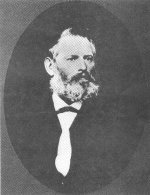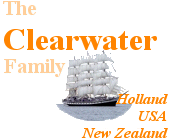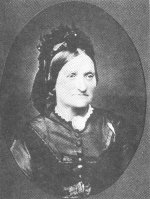The Clearwaters of Otago
 GARRETT HOPPERCLEARWATER was born in Paramus, Bergen,
New Jersey, U.S.A. on 25th May, 1816, third son of Frederick and
Hester Clearwater. He was baptised in the Dutch Reform Church
on 16th June, 1816 and emigrated to New Zealand in 1838, possibly
by whaling boat, one of the many American boats working in New
Zealand waters at that time. GARRETT HOPPERCLEARWATER was born in Paramus, Bergen,
New Jersey, U.S.A. on 25th May, 1816, third son of Frederick and
Hester Clearwater. He was baptised in the Dutch Reform Church
on 16th June, 1816 and emigrated to New Zealand in 1838, possibly
by whaling boat, one of the many American boats working in New
Zealand waters at that time.
The first mention of Garrett Hopper Clearwater in New Zealand
is in "New Zealand Biographies" in an extract on the
Clearwater family of Otago, which states he settled in Otago in
1838. In the 1840s, he appears as a resident of the Otakou area, mentioned in Octavious Harwood's memoirs (click the photo to see a larger version) and is variously described as a boatbuilder, carpenter, cabinet maker, cooper, ship's carpenter, sawyer and joiner.
 There is at least one form in existence which Garrett made for the use of the Methodists when they held services in Weller Brothers or Harwoods buildings under Revs. James Watkin and Charles Creed. It is in the Otago Settlers Museum. There is at least one form in existence which Garrett made for the use of the Methodists when they held services in Weller Brothers or Harwoods buildings under Revs. James Watkin and Charles Creed. It is in the Otago Settlers Museum.
Garrett teamed up with Jim Cullen who also landed on the Peninsula
around 1838. The pair were at Bluff ten years later when they
heard of the coming of the "Philip Laing" from Scotland,
which was bound for Otago. They decided to walk back to Otago
and arrived in time to see the passengers disembark -among whom
was Isabella Blair Stevenson, the matron, and her two daughters.
It is a tradition of the Cullen and Clearwater families that the
two young men eyed the two daughters as they walked down the gangway.
One said "that one is mine" and his friend said "I
will take the other". It has not been decided who actually
had the first pick, but Garrett married Ann Stevenson on 15th
December, 1848, at her mother's home. They took up land on the
Otago Peninsula, where they had a family of six sons and one daughter.
In fact their first two children, a daughter and a son, were twins
and possibly the first white twins born in Otago.
Between 1848 and 1855 his name appears several times in Dr Burns'
Visitation Book, first as an Episcopalian and unmarried, then
with his wife, Ann, and as the years passed, with a growing number
of children. Times were hard and the only education some of the
family had was six weeks at a night school.
During those years he linked up with two neighbouring settlers,
John Styles and James Gwyn, and these three were associated in
different activities. A short distance up the gully at Company's
Bay there is still to be seen the site of their old saw pit. There
is a story told of these days when these men were engaged in getting
out masts and spars for a ship which had come up the harbour dismantled
in a storm. While they were at work the captain of the ship, fearing
that his crew would desert, had them locked up in the local jail
until his ship was ready to sail. He then marched them aboard
under police escort and engaged three local men to help work the
ship outside the heads and the three men rowed back. The last
they saw of the captain he was standing on the deck with a pistol
in each hand ordering his men to work.
These three -Clearwater, Style and Gwyn -were also together when
they followed the gold rush to Gabriel's Gully. They were not
among the successful ones as miners, and claimed that if they
had taken their bush and carpentry tools with them it would have
been a more profitable venture.
There is also a story of Clearwater, Williams and some Maories
going out to endeavour to catch some cattle, which had run wild
on the flat near Cape Saunders. Before there was adequate fencing
and because of the shortage of food day cows were turned into
the bush. They often wandered and became wild and escaped human
attention by going to Cape Saunders and Sandfly Bay. Anderson,
Rowan, Burns and Harwood all had cattle, so Harwood and the group
went off to recover his cattle.
John McLay who arrived with his parents in 1849 as a child of
eight, wrote the following description of Clearwater as he appealed
to a child -"The man that is going to saw timber for Mr Todd's
house, his name is Clearwater, he belongs to America, he is a
splended bush man, a Great Man with an axe -and at the same time
he don't forget to let us know of it and tells my father that
the axes and hoes that we have brought from Home are not any good
-that an English axe was not a bit good to clear bush or to fall
a big tree. The American axe that he worked with was worth a dozen
of the ones we had -his Axe was called a Sharp, the very best
brand of axes made and that he could lay a spike nail on a stump
of a tree and cut it in half and not leave a mark on the axe -and
he did cut a spike in half to let my father see what he said was
true -it was quite right -and that the best thing he could do
with his axes was make them into grub hoes to work bush land with
-and they did -and they made splendid hoes for that work as you
cut the roots with them like an axe -those axes of the Sharp brand
was the axe that was mostly used for years by all bush men -and
when I grew up to be a man I always worked with one at bush work."
Garrett was a powerful man and a splendid man in the bush at
heavy work such as falling large trees and getting them to the
saw pit, which was a hardjob. He was of splendid physique and
a man qualified in many respects. There are stories of him being
called upon to set a broken leg and amputate a finger, both operations
being quite successful.
In those days Otago Peninsula was called upon to supply much
of the farm produce, milk, butter, potatoes, vegetables, for the
Dunedin market. There was also a large demand from the ships at
Port Chalmers for fresh foods. The water way from Broad Bay provided
comparatively easy way of transport and many settlers owned their
own boats, the hills were very steep and the produce had to be
carried to beach or jetty. It was some time before tracks could
be made and a bullock sledge brought into use. Even then the long
trips up and across the harvour, often in the fact of wind and
tide, called for the most strenuous work on the part of the crews.
The daughter and sons of Garrett were also above average and
all played their part in the early days of Otago. Some of them
took part in an interesting incident when the Port Chalmers railway
line was ready. The name "Glen Dermott" was given to
the Railway Station. This did not suit the young "bloods"
and they quietly painted out the name and repainted their own,
Sawyers Bay, and Sawyers Bay it remained.
The fact that his descendants were recognised and included among
the few guests of honour at the official opening ceremony of the
Centennial Memorial Slab at Otakou in 1931 indicates that he was
among the arrivals of those years.
Ann died in 1875 and was buried at Broad Bay. In 1878 Garrett
and some of his sons began farming at Titipua in Southland. The
farm is situated about three miles from Dacre on the Old Dunedin
Road and is bounded by the Titipua Stream, Cross Road and Two
Creeks farm. The area was 710 acres 2 roods and 31 perches, and
now is two farms. It proved unsuitable for the conditions that
prevailed at that time, and in 1881 it was taken back by the mortgagees
and was sold back to the original owner, Alexander Rennie Hay.
Garrett died in August, 1881, in the Invercargill Hospital, and
is buried in the Eastern Cemetery in Invercargill.
Ann Stevenson
Ann was born in Scotland on 14th March, 1817, and emigrated to
New Zealand with her mother, four brothers and sister, on the
"Philip Laing" in September 1847, r and arrived at Port
Chalmers on 17th April, 1848.
The family consisted of the widow of John Stevenson, Isabella
Blair Stevenson, matron of the Philip Laing, her brother, a grown
family and a married son, Isabella's four sons, William, James,
John and Robert, and two daughters, Jane who became Mrs Cullen,
and Ann who became Mrs Clearwater. The latter name where found
in this country is almost certain to be descended from this union.
William, John and Robert settled on the Taieri, while James went
to Central Otago.
Isabella Blair Stevenson was free Church of Scotland by faith,
and was apparently a lady of some standing to be matron on the
immigrant ship of people who could afford a journey and have enough
means to set themselves up in a new land. Also, she seemed to
retain her maiden name of Blair, and there is a possible connection
with the Duke of Athol whose family name was Blair. The Dukes
of Athol are descended from a daughter of James II of Scotland
and thus to Robert Bruce, he also having come from Norman nobles
of 1066, originally Norse.
It is a belief of some of the Stevenson family that there is
a family connection with Robert Louis Stevenson. Stevensons, acording
to Robert Louis's researchers, came to Glasgow at the beginning
of the 17th century from the western highlands of Scotland where
they lived the quiet unobtrusive lives of farmers, Stevensons
by day and MacGregors by night. The western highlanders were Celts,
Scots, Norse and Danes. The MacGregors sprang from Gregor the
third son of Kenneth McLapine, first king of the Scots and Picts,
descended from the Druid kings of Ireland. |



 GARRETT HOPPERCLEARWATER was born in Paramus, Bergen,
New Jersey, U.S.A. on 25th May, 1816, third son of Frederick and
Hester Clearwater. He was baptised in the Dutch Reform Church
on 16th June, 1816 and emigrated to New Zealand in 1838, possibly
by whaling boat, one of the many American boats working in New
Zealand waters at that time.
GARRETT HOPPERCLEARWATER was born in Paramus, Bergen,
New Jersey, U.S.A. on 25th May, 1816, third son of Frederick and
Hester Clearwater. He was baptised in the Dutch Reform Church
on 16th June, 1816 and emigrated to New Zealand in 1838, possibly
by whaling boat, one of the many American boats working in New
Zealand waters at that time.